KIERKEGAARD AND THE LIFE OF FAITH
INDIANA SERIES IN THE PHILOSOPHY OF RELIGION
Merold Westphal, editor
KIERKEGAARD AND THE LIFE OF FAITH
The Aesthetic, the Ethical, and the Religious in Fear and Trembling
Jeffrey Hanson

This book is a publication of
Indiana University Press
Office of Scholarly Publishing
Herman B Wells Library 350
1320 East 10th Street
Bloomington, Indiana 47405 USA
iupress.indiana.edu
2017 by Jeffrey Hanson
All rights reserved
No part of this book may be reproduced or utilized in any form or by any means, electronic or mechanical, including photocopying and recording, or by any information storage and retrieval system, without permission in writing from the publisher. The Association of American University Presses Resolution on Permissions constitutes the only exception to this prohibition.
 The paper used in this publication meets the minimum requirements of the American National Standard for Information SciencesPermanence of Paper for Printed Library Materials, ANSI Z39.481992.
The paper used in this publication meets the minimum requirements of the American National Standard for Information SciencesPermanence of Paper for Printed Library Materials, ANSI Z39.481992.
Manufactured in the United States of America
Library of Congress Cataloging-in-Publication Data
Names: Hanson, Jeffrey, author.
Title: Kierkegaard and the life of faith : the aesthetic, the ethical, and the religious in Fear and trembling / Jeffrey Hanson.
Description: 1st [edition]. | Bloomington : Indiana University Press, 2017. |
Series: Indiana series in the philosophy of religion | Includes bibliographical references and index.
Identifiers: LCCN 2016042293 (print) | LCCN 2016045061 (ebook) | ISBN 9780253024701 (cloth : alk. paper) | ISBN 9780253025029 (e-book)
Subjects: LCSH: Kierkegaard, Sren, 1813-1855. Frygt og bven. | ChristianityPhilosophy. | Abraham (Biblical patriarch) | SinChristianity.
Classification: LCC BR100.K523 H36 2017 (print) | LCC BR100.K523 (ebook) | DDC 198/.9dc23
LC record available at https://lccn.loc.gov/2016042293
1 2 3 4 5 22 21 20 19 18 17
Dedication
For the ones who taught me the little mystery:
My father, George
My mother, Danielle
My sister, Jamie
And the ones who taught me the great mystery:
My wife, Roxene
My son, Tristan
The true religious existence is to be as if demolished for this lifebut still to consider oneself blessed.
Kierkegaard, Journals and Papers
Contents
Acknowledgments
PORTIONS OF THIS book have appeared in print before as The Shipwreck of the Aesthetic and Ethical, Graduate Faculty Philosophy Journal 32, no. 2 (2011): 371405, reprinted by permission of Philosophy Documentation Center; He Speaks in Tongues: Hearing the Truth of Abrahams Words of Faith, in Kierkegaards Fear and Trembling: A Critical Guide, edited by Daniel Conway (Cambridge: Cambridge University Press, 2015), 22946, reprinted by permission of Cambridge University Press; and The Phenomenon of the Good: Reconstructing Religion in the Wake of Deconstruction, in Reexamining Deconstruction and Determinate Religion: Toward a Religion with Religion, edited by J. Aaron Simmons and Stephen Minister (Pittsburgh, PA: Duquesne University Press, 2012), 13154, reprinted by permission of Duquesne University Press.
KIERKEGAARD AND THE LIFE OF FAITH
Introduction
FEAR AND TREMBLING was famously recognized by its author as being sufficient among his writings to secure his everlasting fame as an author, but the text has arguably proven to have a captivating power beyond even what Kierkegaard himself imagined. It has been read and reread and puzzled over and argued about in countless languages and in numberless papers and books. So why presume to write yet another book on Fear and Trembling? Because while many books have recently appeared in English that seek to clarify this text (and indeed many of them have done a marvelous job), none has sought to interpret it anew. And such an interpretation is required today because many of the interpretations that have been lately offered are incomplete in scope or woefully off the point. Some are both.
The current interpretation takes in the whole of Fear and Trembling; in fact, it is the argument of this book that Problema III, which has in some interpretations been wholly ignored and in none has received pride of place, is in fact a key portion of the text, containing the final elaboration of all of its most important points. A convincing reading of Fear and Trembling can no more afford to truncate the text in this way than Platos Republic can be properly understood by stopping at the end of Book VII. By downplaying or even discounting Problema III many interpreters fail to see that the life of faith not only suspends and reinvents the ethical but also suspends and reinvents the aesthetic, providing a complete picture of how the knight of faith realizes in a new way the demands of both goodness and beauty. The current interpretation likewise seeks to place Fear and Trembling in direct relationship with the most important references that Kierkegaard himself made to his own work, chief among these a long footnote in the introduction to The Concept of Anxiety that provides an indispensable Ariadnes thread for the course of this book.
Furthermore, the current interpretation dispenses with a proliferation of misunderstandings of this text that are united by their central conviction that Fear and Trembling involves at its core a conflict between religion and ethics, between the good and the holy, or between an absolute and a generalized responsibility. The argument of this book is that this conflict, which has been the presupposition of pages and pages of commentary on Fear and Trembling, isat besta subordinate concern of the text. Insofar as there is a central conflict thematized in this book, that conflict is between the rigorous demand of faith that comes from God and the humanly devised ethical systems that are usually considered sufficient (by both pre-Christian and spiritless pseudo-Christian cultures) to secure the good life. More interesting to Kierkegaard in the end, however, is not the conflict between these modes of life but the manner in which the demand of faith necessarily transforms the ethical vision while overcoming it; in short, his interest is in the way in which our vision of the Good is broken by, and then rebuilt by, our encounter with God. Kierkegaard has almost no interest whatsoever in how or whether the apparently unethical can be explained or excused by recourse to faith; what he is trying to do is alarm a complacently Christian audience of readers into recognizing what their faith actually requires of them and the extent to which real adherence to that faith should alter the entirety of their lives.
Fear and Trembling is very simply principally about how faith changes the whole of life and does so in ways that are often elusive and difficult to discriminate as distinct from the style of life pursued by many nonfaithful (but nonetheless admirable) people. The life of faith nevertheless can be described and, more important, can certainly be lived out. Faith changes the whole of life in three principal manners that Fear and Trembling concerns itself with.
First, it changes the faithful persons response to the world, especially her response to life at its most challenging: faith is a means of coping with the inevitable losses, heartbreaks, and difficulties presented by life and enables an appreciation of life as a gift without discounting the very real and legitimate sense in which life remains deeply objectionable on humanly constructed ethical and aesthetic terms. This aspect of faiths work is consistently opposed, both by Johannes de Silentio and by Kierkegaards authorship as a whole, to the pagan conception of fate and stoic resolve in the face of fate. Fate remains forever ambiguous and unreconciled to lifes goodness, which only faith wholeheartedly, and not naively, affirms.
Next page

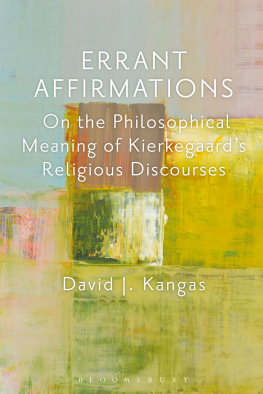
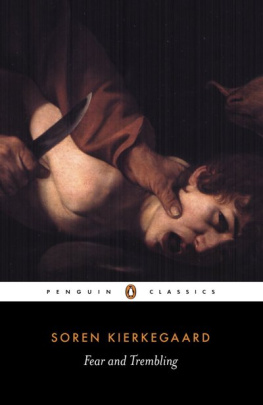
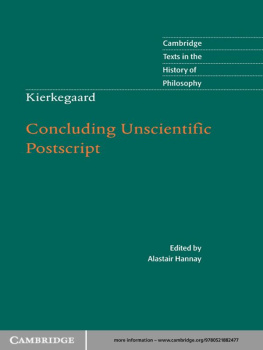
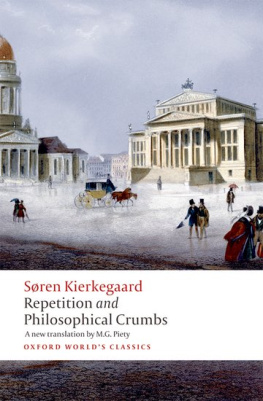
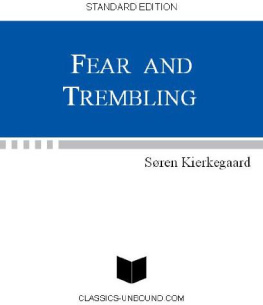

 The paper used in this publication meets the minimum requirements of the American National Standard for Information SciencesPermanence of Paper for Printed Library Materials, ANSI Z39.481992.
The paper used in this publication meets the minimum requirements of the American National Standard for Information SciencesPermanence of Paper for Printed Library Materials, ANSI Z39.481992.